Entrée Pairings
Our 2012 Syrah with its dark wild berry, cherry, cassis, cocoa, mocha, anise and pepper flavors and aromas (and hints of smoke and numerous other spices) is incredibly versatile. It pairs wonderfully with grilled steak, rib-eye, rib roast, short ribs, beef stew, pork, lamb, duck, roast turkey, salmon, sausage, spicy chicken dishes, softer aromatic cheeses, cioppino, eggplant or cauliflower.
Fruit-based sauces made from blueberries, dark cherries, figs, blackberries and cassis will complement the dark fruit characteristics of the wine.
Spices such as anise, black pepper, rosemary, oregano, lavender, fennel, cumin, thyme and clove will bring forth the naturally occurring spice notes of the Syrah
Stronger more flavorful cheeses like cheddar, blue and robust old world varieties are the best matches for our flagship Syrah
We suggest you experiment with differing meat, fruit, spice and cheese combinations to explore the infinite pairing potential of our 2012 Syrah. And remember, Syrah pairs great with bold foods!! For some of our favorite combinations please check out some of the following recipes. Enjoy!
- Recipes
- Steak Frites with Whiskey Butter and Asparagus
- Spicy Barbecued Rib-Eye Steaks with Smoked Vegetable Salsa
- Duck Breast with Crème Fraîche and Roasted Grapes
- Pork Medallions with Mustard-Chive Sauce
- Chicken and Andouille Sausage Ragù
- Spice-Crusted Rack of Lamb
- Grilled Pork Tenderloin with Fresh Fig Skewers
- Chicken Tagine with Spring Vegetables
- Spice-Crusted Rack of Lamb
- Black Pepper-Crusted Standing Rib Roast au Jus
- Roast Turkey with Bourbon Gravy
- Chicken Tagine with Spring Vegetables
- Quick and Easy Cioppino
- Crown Roast of Lamb with Rosemary and Oregano
- Braised Short Ribs with Red Wine and Pureed Vegetables
- Red Wine Beef Stew
- Coal-Roasted Eggplants
- Eggplant with Lentils and Goat Cheese
- Cauliflower Steaks with Olive & Herb Salsa
- Caramelized Onion & Eggplant Puff Pastry Tart with Kalamata Olives, Roasted Red Peppers & Basil
- Grilled Salmon with Quick Blueberry Pan Sauce
- Grilled Pork Tenderloin with Fresh Fig Skewers
- Open-Face Lamb Burgers with Pistachio-Apricot Relish
- Duck With Cherries and Red Wine Vinegar
Click on the tabs to the left to view our pairing favorites
- Steak Frites with Whiskey Butter and Asparagus
- Spicy Barbecued Rib-Eye Steaks with Smoked Vegetable Salsa
- Black Pepper-Crusted Standing Rib Roast au Jus
- Braised Short Ribs with Syrah and Pureed Vegetables
- Syrah Beef Stew
- Grilled Pork Tenderloin with Fresh Fig Skewers
- Pork Medallions with Mustard-Chive Sauce
- Crown Roast of Lamb with Rosemary and Oregano
- Spice-Crusted Rack of Lamb
- Open-Face Lamb Burgers with Pistachio-Apricot Relish
- Duck With Cherries and Red Wine Vinegar
- Duck Breast with Crème Fraîche and Roasted Grapes
- Roast Turkey with Bourbon Gravy
- Chicken and Andouille Sausage Ragù
- Chicken Tagine with Spring Vegetables
- Grilled Salmon with Quick Blueberry Pan Sauce
- Quick and Easy Cioppino
- Coal-Roasted Eggplants
- Eggplant with Lentils and Goat Cheese
- Caramelized Onion & Eggplant Puff Pastry with Kalamata Olives, Roasted Red Peppers & Basil
- Cauliflower Steaks with Olive & Herb Salsa
- Cheese Pairings

Steak Frites with Whiskey Butter and Asparagus
BY ELIZABETH KARMEL APRIL 2008 GIRLS AT THE GRILL
Makes 4 servings
Ingredients
Whiskey Butter:
2 sticks unsalted butter, softened
2 shallots minced, soaked in 1 shot of Jack Daniels or other whiskey or bourbon
3 teaspoons minced parsley
1/2 teaspoon Worcestershire sauce
White pepper to taste
Steaks:
4 cowboy steaks, bone-in rib eye steaks, or other favorite steak, about 1-inch thick
1 teaspoon kosher salt
1/4 teaspoon whole black peppercorns, coarsely ground
Olive oil
Chopped parsley, optional
Asparagus
Frites
Preparation
Grilling Method: Combo/Medium-High
Make Whiskey Butter:
Make Butter at least 3 hours in advance. Combine butter, shallots soaked in Jack Daniels (or other bourbon or whiskey), parsley, Worcestershire, mustard, whiskey, salt, and pepper. Mix well. On a piece of plastic wrap, drop butter in spoonfuls to form a log. Roll butter in plastic wrap and smooth out to form a round log. Refrigerate until hard and easy to slice into round, coin-shaped pieces.
Prepare Steaks:
Allow meat to come to room temperature about 15 minutes before grilling.
Just before grilling, brush both sides of the steaks with the oil and season with salt and pepper.
Place steaks directly over medium-high heat for about 1 to 2 minutes, just long enough to get good grill marks. Turn steaks and sear the other side. Move steaks to indirect heat and continue cooking for about 7 more minutes for medium rare.
Remove steaks from the grill, top with a pat of the whiskey butter and allow to rest at least 5 minutes but no longer than 10 before serving.
Spread the melted butter all over the tops of the steaks and top each with a fresh slice of the whiskey butter and parsley, if desired.
Homemade Frites
As prepared by Macheesmo, October 2013
Real Belgian style frites made at home!
Ingredients
FRITES
- 4 large russet potatoes, sliced
- 2 quarts vegetable or peanut oil
- Kosher salt
HONEY MUSTARD
- 1/4 cup dijon mustard
- 2 tablespoons honey
WASABI KETCHUP
- 1/4 cup ketchup
- 1 teaspoon wasabi paste
Preparation
Peel potatoes and cut into 1/4-inch matchsticks. Submerge fries in cold water while you slice the others to prevent browning.
Heat a large pot of oil to exactly 325°F. Use a deep fry thermometer!
Dry fries well in batches and once dry, add slowly to oil. Fry the potatoes for 4 minutes then remove and let drain. They will be mostly cooked at this point, but not browned at all.
When all the frites are fried, heat oil to 375°F.
When oil is hot, cook the fries for a second time in the hotter oil for 3-4 minutes. They should turn perfectly crispy and brown.
Remove fries from oil and let drain on a few paper towels. Season fries immediately with salt while hot.
Serve fries over steak with a little honey mustard and wasabi ketchup on the side for dipping.
STEP BY STEP
There’s no need to get fancy on the potato front for these. Just plain Russet potatoes work great. Peel them and cut them into planks and then fries. I shoot for fries that are about 1/4-inch thick. The annoying part of making really good potatoes is that you have to fry them twice. There’s just no other way. While this does take a bit more skill and time, it’s not actually that much more work since you already have a frying setup.
Once your fries are chopped, move them to a large bowl of cold water. This does two things: First, it ensures that your potatoes don’t turn brown – which can lead to a pretty unappealing fry. Second, and more importantly, it washes off the starch on the potatoes which will keep them from sticking together as they are frying.
The first fry is at a low temperature (325 degrees F). Temperature is really important, so be sure to use a thermometer and don’t eyeball it. If the oil is too hot, you’ll end up with flimsy French fries instead of perfect frites. Once your oil is the right temperature, remove a handful of fries from the water and dry them very well (unless you like grease fires). Once the fries are dry, gently add them to the oil and let them fry for 5 minutes. Add them slowly to the pot and make sure not to add too many at once or your oil might overflow.
Once the fries have fried for five minutes, remove them with tongs. They will look very unappealing at this point and that’s okay. The important part is that they are cooked and most of the liquid is removed from the fries.
Now for the fun part. Once you have fried all of your potatoes at the low temperature, let them drain and cool while you crank the temperature up on your oil to a blistering 375 degrees F. You might not think that 50 degrees makes a difference, but it is huge. When your oil hits that temperature, again, fry the potatoes in batches for 3-4 minutes until they are golden brown. On this second, much hotter fry, they will immediately crisp up and turn a perfect golden brown.
When they come out of the fryer, season them with salt immediately. Serve them over your grilled steak with some wasabi ketchup and honey mustard on the side for dipping.
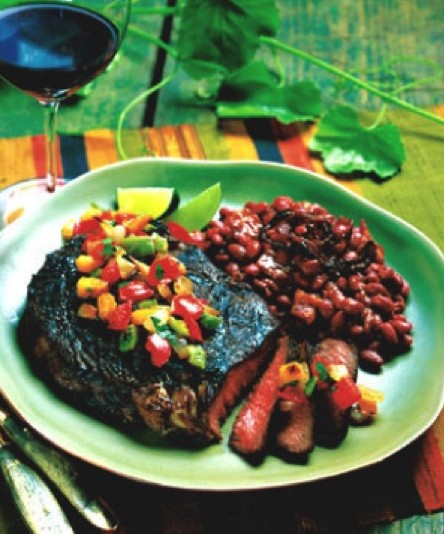
Spicy Barbecued Rib-Eye Steaks with Smoked Vegetable Salsa
Epicurious
BON APPÉTIT OCTOBER 2002
Makes 8 servings
Ingredients
2/3 cup (packed) dark brown sugar
1/3 cup coarse salt
1/4 cup chili powder
1/4 cup coarsely ground black pepper
1 tablespoon ground cumin
2 teaspoons ground coriander
1 teaspoon ground cloves
9 garlic cloves, pressed
8 16-ounce boneless rib-eye steaks
3/4 cup corn oil
Smoked Vegetable Salsa
Preparation
Mix first 7 Ingredientsin medium bowl. Using fork, mash in garlic. Using 3 tablespoons spice mixture for each steak, rub spices onto both sides of steaks. Whisk corn oil into remaining spice mixture; set oil rub aside. Place steaks in two 13x9x2-inch glass dishes. Cover; chill steaks and oil rub at least 4 hours and up to 1 day.
Prepare barbecue (medium-high heat). Brush steaks with some of oil rub. Grill steaks to desired doneness, brushing occasionally with oil rub, about 5 minutes per side for medium-rare; let stand 5 minutes. Serve with Smoked Vegetable Salsa .
Epicurious
BON APPÉTIT OCTOBER 2002
YieldMakes about 5 cups
Ingredients
1 1/2 pounds plum tomatoes, halved lengthwise
4 large fresh Anaheim chilies,* halved lengthwise, seeded
1 large onion, quartered lengthwise
1 large yellow bell pepper, quartered
1 head of garlic, top 1/3 cut off, head left intact
1/4 cup corn oil
2 cups hickory-wood chips, soaked in water 1 hour, drained
1 9-inch-diameter disposable aluminum foil pie pan
1/3 cup chopped fresh cilantro
1/4 teaspoon cayenne pepper
Preparation
Combine first 5 Ingredients in large bowl. Add oil; toss gently to coat. Sprinkle generously with salt and pepper.
Prepare barbecue (medium-high heat). Arrange hickory chips in foil pie pan; place directly atop coals. Allow chips to begin smoking, about 10 minutes. Grill vegetables until tender, turning frequently, about 10 minutes for tomatoes, 20 minutes for chilies, onion, and bell pepper, and 35 minutes for garlic. Transfer vegetables to cutting board. Cool. Remove any loosened peel from tomatoes, chilies, and bell pepper. Peel garlic. Coarsely chop all vegetables; transfer to medium bowl. Mix in cilantro and cayenne pepper. Season with salt and pepper. (Can be made 8 hours ahead. Cover; chill. Bring to room temperature before serving.)
Also known as California chilies. Available at Latin American markets and many supermarkets.
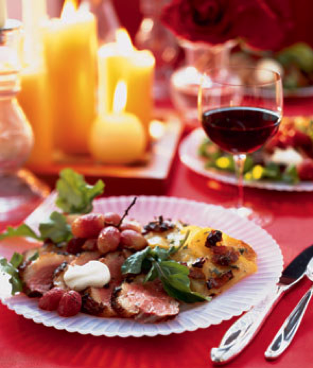
Duck Breast with Crème Fraîche and Roasted Grapes
Epicurious
BON APPÉTIT FEBRUARY 2004
Makes 6 servings
Ingredients
6 6- to 8-ounce duck breasts (thawed if frozen)
1 tablespoon dried juniper berries, crushed in resealable plastic bag using flat side of mallet
1 tablespoon fresh thyme leaves
1/2 pound purple seedless grapes, cut into small clusters
1/2 tablespoon olive oil
Coarse kosher salt
3 cups arugula
1/4 cup crème fraîche or sour cream, stirred to loosen
Preparation
Using sharp knife, score skin of duck breast diagonally to create 3/4-inch-wide diamond pattern. Sprinkle crushed juniper berries and thyme over both sides of breast; press to adhere. Place on rimmed baking sheet, cover with plastic wrap, and refrigerate at least 4 hours. (Can be prepared 1 day ahead. Keep refrigerated.)
Preheat oven to 500°F. Arrange grape clusters in single layer on baking sheet. Drizzle with olive oil and sprinkle with kosher salt and pepper. Roast until skins are slightly crisp but grapes are still soft and juicy inside, about 14 minutes. Cool. (Can be made 4 hours ahead. Let stand at room temperature.)
Sprinkle both sides of duck breasts with salt and pepper. Heat heavy large skillet over medium heat. Add duck, skin side down; cook until almost all fat is rendered, about 7 minutes. Increase heat to medium-high and cook until skin is brown and crisp, about 4 minutes. Turn duck over and cook about 3 minutes longer for medium-rare. Let duck rest 5 minutes.
Divide arugula among 6 plates. Thinly slice duck breasts crosswise and fan out slightly; place 1 breast atop arugula on each plate. Drizzle crème fraîche over each breast. Divide grapes among plates.
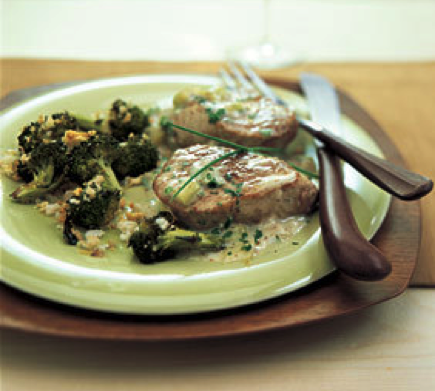
Pork Medallions with Mustard-Chive Sauce
Epicurious
BON APPÉTIT OCTOBER 2004
Makes 6 servings
Ingredients
2 tablespoons (1/4 stick) butter, divided
2 tablespoons olive oil, divided
2 cups chopped leeks (white and pale green parts only; about 2 medium)
1 cup low-salt chicken broth
1/2 cup dry white wine
2 garlic cloves, minced
1/2 cup crème fraîche or sour cream
3 tablespoons whole grain Dijon mustard
2 1-pound pork tenderloins, each cut crosswise into 6 slices
2 tablespoons chopped fresh chives
1 tablespoon chopped fresh tarragon
2 tablespoons chopped fresh parsley
Preparation
Melt 1 tablespoon butter with 1 tablespoon oil in large skillet over medium-high heat. Add leeks and cook until beginning to turn golden, stirring frequently, about 5 minutes. Stir in broth, wine, and garlic. Boil until mixture is reduced to 1 2/3 cups, about 4 minutes. Whisk in crème fraîche and mustard; set aside. (Sauce can be made 2 hours ahead. Let stand at room temperature.) Melt 1 tablespoon butter with 1 tablespoon oil in another large skillet over medium-high heat. Sprinkle pork with salt and pepper. Sauté until browned and cooked, about 5 minutes per side. Transfer pork to platter. Add sauce to skillet; simmer sauce over medium heat until slightly thickened, scraping up any browned bits, about 2 minutes. Stir in chopped chives and tarragon. Season with salt and pepper.
Return pork to skillet. Cook over medium heat just until rewarmed, stirring frequently, about 1 minute. Transfer to platter, sprinkle with parsley, and serve.

Chicken and Andouille Sausage Ragù
Epicurious
BON APPÉTIT FEBRUARY 2003
Makes 6 servings
Ingredients
9 chicken thighs with skin and bones (about 4 pounds), well trimmed
2 tablespoons olive oil
1 pound chicken andouille sausage or other fully cooked spicy smoked sausage, cut into 1/2-inch-thick rounds
3 medium carrots, peeled, diced
2 large onions, chopped
1/2 cup chopped fresh marjoram (from about 2 large bunches)
6 garlic cloves, minced
1 teaspoon grated lemon peel
1/4 teaspoon dried crushed red pepper
1 cup dry white wine
2 14 1/2-ounce cans diced tomatoes in juice
2 cups low-salt chicken broth
Campanelle Pasta with Parsley Butter
Preparation
Place chicken thighs, skin side down, on work surface. Using sharp knife, cut each thigh lengthwise along each side of bone, forming 2 pieces of meat (some meat may remain on bones); reserve bones.
Heat oil in heavy large pot over medium-high heat. Sprinkle chicken and bones with salt and pepper. Working in batches, sauté in pot until brown, about 6 minutes per batch. Transfer to bowl. Add sausage to pot and sauté until brown, about 5 minutes. Using slotted spoon, transfer to bowl with chicken. Add carrots and onions to pot and sauté until onions are tender and golden, about 10 minutes. Stir in 1/4 cup marjoram, garlic, lemon peel, and crushed red pepper; sauté 2 minutes. Add wine and boil until reduced by half, about 3 minutes. Stir in tomatoes with juices and broth; bring to boil. Add chicken, bones, sausage, and any accumulated juices from bowl. Reduce heat, cover, and simmer until chicken is cooked through, about 35 minutes.
Using slotted spoon, transfer chicken and sausage to bowl; discard bones. Boil liquid in pot until reduced to 3 cups, about 20 minutes. Stir in remaining 1/4 cup marjoram. Season to taste with salt and pepper. Return chicken and sausage to pot. (Can be made 1 day ahead. Cool slightly. Refrigerate uncovered until cold, then cover and keep refrigerated. Rewarm over medium heat before serving.) Spoon ragù over Campanelle Pasta with Parsley Butter.
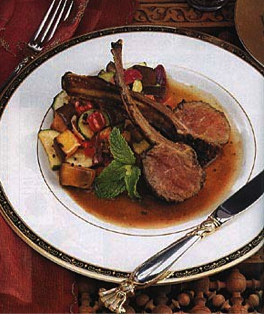
Spice-Crusted Rack of Lamb
Epicurious
BON APPÉTIT JANUARY 2000
Makes 6 servings
Ingredients
2 tablespoons whole coriander seeds
4 teaspoons black peppercorns
2 teaspoons cumin seeds
12 whole cloves
1 teaspoon ground turmeric
3/4 teaspoon cardamom seeds (from whole green pods)
3 tablespoons vegetable oil
2 pounds meaty lamb neck bones
2 celery stalks, chopped
1 cup chopped onion
8 large garlic cloves, chopped
2 tablespoons chopped peeled fresh ginger
3 small bay leaves, crumbled
2 large plum tomatoes, chopped
5 cups canned low-salt chicken broth
1/2 cup dry white wine
1/4 cup chopped fresh mint
3 1 1/4-pound lamb racks
Preparation
Blend all spices to powder in grinder or mill. Transfer spice rub to small bowl.
Heat oil in heavy large pot over medium-high heat. Add bones; saut&é until brown, about 10 minutes. Add celery, onion, garlic, ginger and bay leaves. Reduce heat to medium; saut&é until celery is tender, about 5 minutes. Mix in tomatoes and 2 tablespoons spice rub; stir 2 minutes. Add broth, wine and mint. Bring to boil. Reduce heat to medium-low; cover and simmer 1§ hours. Strain into medium saucepan, pressing hard on solids in sieve. Spoon fat off top of broth; reserve fat for use with lamb. Boil broth until reduced to 1§ cups, about 25 minutes. Season sauce to taste with salt and pepper; set aside.
Brush each lamb rack with some of reserved lamb fat. Sprinkle each rack with salt and pepper; rub each with 1 tablespoon spice rub. Place on rimmed baking sheet. Let stand at room temperature 2 hours. (Sauce and lamb can be prepared 1 day ahead. Cover separately; chill. Bring lamb to room temperature before continuing.) Preheat oven to 400°F Heat large skillet over high heat. Sear 1 lamb rack on all sides until brown, about 8 minutes. Return to baking sheet. Repeat with remaining lamb racks. Roast lamb until thermometer inserted into center registers 125°F for rare, about 25 minutes.
Rewarm sauce. Cut lamb between bones into chops. Divide lamb among 6 plates. Spoon sauce over lamb.
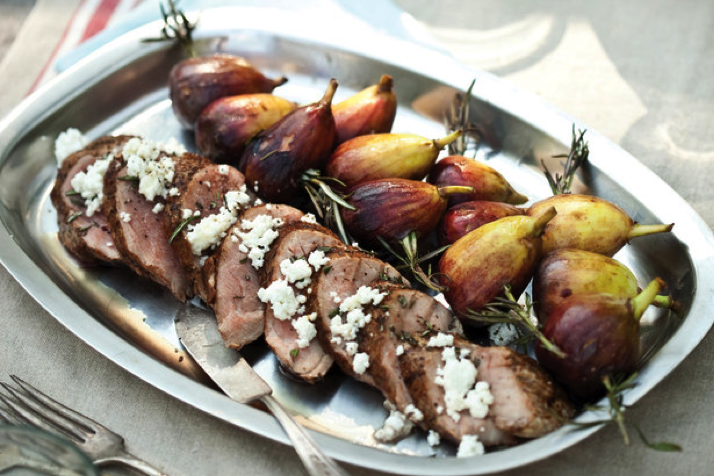
Grilled Pork Tenderloin with Fresh Fig Skewers
BY KAREN ADLER & JUDITH FERTIG APRIL 2012 THE GARDENER & THE GRILL
Makes 4 servings
Ingredients
One (1 to 1 1/4 pounds) pork tenderloin or center-cut pork filet
2 tablespoons olive oil
Fine kosher or sea salt and freshly ground black pepper to taste
4 long rosemary branches or wooden skewers, soaked in water for at least 15 minutes
12 small ripe figs
4 ounces goat cheese
2 teaspoons honey
1 1/2 teaspoons finely chopped fresh rosemary
Preparation
Prepare a hot fire in your grill. Brush the tenderloin with the olive oil and season with salt and pepper.
Remove the skewers from the water. Pierce the figs through the middle with a metal skewer or ice pick to make a hole. Then thread 3 figs onto each rosemary or wooden skewer. Lightly brush the figs with olive oil.
Place the pork tenderloin directly over the fire. Grill for 2 to 3 minutes per side (the center-cut pork loin filet for 5 to 7 minutes per side), turning a quarter turn at a time, until an instant-read meat thermometer inserted in the thickest part registers 140°F for medium and the meat is juicy and slightly pink in the center.
At the same time, place the skewered figs over the fire, turning several times and cooking for about 5 to 6 minutes until they are heated through. When they’re caramelized and soft, remove the skewers from the heat and keep warm.
Let the pork rest for about 5 minutes, and then cut on the diagonal into 1- to 2-inch-thick slices.
To serve, arrange 3 slices of pork with a skewer of figs on each plate, all topped with crumbled goat cheese, drizzled with 1/2 teaspoon honey, and a sprinkled with chopped rosemary.
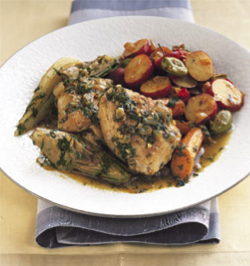
Chicken Tagine with Spring Vegetables
Epicurious
BON APPÉTIT APRIL 2003
Makes 8 servings
Ingredients
1 lemon, halved
6 medium artichokes, stems trimmed to 1/2 inch
1/2 cup (about) olive oil
1 pound onions, chopped
8 large garlic cloves, chopped
3 tablespoons (packed) grated lemon peel
1 tablespoon ground coriander
2 teaspoons Hungarian sweet paprika
1 1/2 teaspoons ground cumin
1 1/2 teaspoons ground ginger
1/4 teaspoon cayenne pepper
8 tablespoons chopped fresh parsley
8 tablespoons chopped fresh dill
8 tablespoons chopped fresh mint
4 pounds skinless boneless chicken thighs, trimmed of excess fat
4 cups low-salt chicken broth
3 fresh fennel bulbs, trimmed, bulbs quartered vertically
5 large carrots (about 1 1/2 pounds), peeled, cut into 1-inch lengths
Preparation
Fill large bowl with water; squeeze in juice from lemon. Working with 1 artichoke at a time, break off enough outer leaves to expose pale green leaves. Trim dark green areas off stem and base. Quarter artichoke lengthwise; trim artichoke quarters to 1 1/2-inch lengths. Scrape out choke; drop quarters into lemon water.
Heat 1/4 cup oil in heavy large skillet over medium-high heat. Add onions and sauté until translucent, about 5 minutes. Add next 7
Ingredients
and 6 tablespoons each parsley, dill, and mint; sauté 3 minutes longer. Scrape contents of skillet into heavy large pot; reserve skillet.
Sprinkle chicken with salt and pepper. Heat 2 tablespoons oil in same skillet over medium-high heat. Add 1/3 of chicken and sauté until golden, about 3 minutes per side. Transfer to pot with onion mixture. Repeat with remaining chicken in 2 more batches, adding more oil by tablespoonfuls if needed. Add broth to skillet; bring to boil, scraping up browned bits. Transfer broth to pot; add fennel and carrots. Drain artichokes and add to pot.
Bring tagine to boil. Cover, reduce heat to medium-low, and simmer until chicken is almost tender, about 20 minutes. Uncover and simmer until chicken and all vegetables are tender, about 15 minutes longer. Using slotted spoon, transfer chicken and vegetables to large bowl. Boil sauce until reduced enough to coat spoon, about 10 minutes. Season with salt and pepper. Return chicken and vegetables to sauce. (Can be made 1 day ahead. Cool slightly. Chill uncovered until cold, then cover and keep refrigerated.)
Rewarm tagine over medium heat. Transfer to large bowl. Sprinkle with 2 tablespoons each of parsley, dill, and mint.

Spice-Crusted Rack of Lamb
Epicurious
BON APPÉTIT JANUARY 2000
Makes 6 servings
Ingredients
2 tablespoons whole coriander seeds
4 teaspoons black peppercorns
2 teaspoons cumin seeds
12 whole cloves
1 teaspoon ground turmeric
3/4 teaspoon cardamom seeds (from whole green pods)
3 tablespoons vegetable oil
2 pounds meaty lamb neck bones
2 celery stalks, chopped
1 cup chopped onion
8 large garlic cloves, chopped
2 tablespoons chopped peeled fresh ginger
3 small bay leaves, crumbled
2 large plum tomatoes, chopped
5 cups canned low-salt chicken broth
1/2 cup dry white wine
1/4 cup chopped fresh mint
3 1 1/4-pound lamb racks
Preparation
Blend all spices to powder in grinder or mill. Transfer spice rub to small bowl.
Heat oil in heavy large pot over medium-high heat. Add bones; saut&é until brown, about 10 minutes. Add celery, onion, garlic, ginger and bay leaves. Reduce heat to medium; saut&é until celery is tender, about 5 minutes. Mix in tomatoes and 2 tablespoons spice rub; stir 2 minutes. Add broth, wine and mint. Bring to boil. Reduce heat to medium-low; cover and simmer 1§ hours. Strain into medium saucepan, pressing hard on solids in sieve. Spoon fat off top of broth; reserve fat for use with lamb. Boil broth until reduced to 1§ cups, about 25 minutes. Season sauce to taste with salt and pepper; set aside.
Brush each lamb rack with some of reserved lamb fat. Sprinkle each rack with salt and pepper; rub each with 1 tablespoon spice rub. Place on rimmed baking sheet. Let stand at room temperature 2 hours. (Sauce and lamb can be prepared 1 day ahead. Cover separately; chill. Bring lamb to room temperature before continuing.) Preheat oven to 400°F Heat large skillet over high heat. Sear 1 lamb rack on all sides until brown, about 8 minutes. Return to baking sheet. Repeat with remaining lamb racks. Roast lamb until thermometer inserted into center registers 125°F for rare, about 25 minutes.
Rewarm sauce. Cut lamb between bones into chops. Divide lamb among 6 plates. Spoon sauce over lamb.

Black Pepper-Crusted Standing Rib Roast au Jus
Epicurious
BON APPÉTIT DECEMBER 2002
Makes 8 servings
Ingredients
1 8 1/2-pound standing rib roast (weight with bones), top fat trimmed
Vegetable oil
12 tablespoons (1 1/2 sticks) unsalted butter, room temperature
2 tablespoons cracked or coarsely ground black pepper
4 large garlic cloves, minced
1/2 teaspoon salt
2 1/4 cups low-salt beef broth
1/2 cup dry red wine
Roasted Red Onions
1 large bunch watercress
Preparation
Place roast, fat side up, in roasting pan. Brush exposed ends of roast with vegetable oil. Sprinkle roast lightly all over with salt. Mix 8 tablespoons butter, 2 tablespoons cracked pepper, minced garlic, and 1/2 teaspoon salt in small bowl. Reserve 2 tablespoons pepper butter for sauce. Spread remaining pepper butter all over top (fat side) of roast. (Can be prepared 1 day ahead. Cover roast and reserved pepper butter separately; chill.)
Position rack in bottom third of oven and preheat to 350°F. Roast rib roast until instant-read thermometer inserted into thickest part of meat registers 125°F for medium-rare, about 2 hours 45 minutes. Transfer roast to platter and cover loosely with foil; let rest 30 minutes (temperature will rise slightly as roast stands).
Strain pan juices from roasting pan into measuring cup. Skim off any fat from top of pan juices; discard fat. Return pan juices to roasting pan; set pan over 2 burners. Add broth and wine to roasting pan and boil over high heat until liquid is reduced to 1 1/4 cups, scraping up any browned bits from bottom of pan, about 6 minutes. Whisk in reserved pepper butter and remaining 4 tablespoons plain butter. Season with more salt and pepper, if desired.
Epicurious
Roasted Red Onions
BON APPÉTIT DECEMBER 2002
YieldMakes 8 servings
Ingredients
3 pounds small red onions (about 9), halved through root end, then cut into 3/4-inch-wide wedges with some of core attached to each
1/4 cup (1/2 stick) butter, melted
1 1/2 teaspoons dried thyme
1 1/2 teaspoons coarse salt
1/2 teaspoon ground black pepper
2 tablespoons red wine vinegar
Preparation
Position 1 rack in bottom third and 1 rack in top third of oven and preheat to 450°F. Line 2 large baking sheets with foil; butter foil generously. Arrange onion wedges cut side down on prepared sheets. Brush onions with melted butter. Mix thyme, salt, and pepper in small bowl; sprinkle over onions. Drizzle with vinegar. Cover baking sheets tightly with foil. Roast onions 20 minutes. Reverse baking sheets from top to bottom and continue to roast until bottoms of onion wedges are brown, about 20 minutes longer. Remove foil. Using spatula, turn onion wedges over; cover with foil and roast until bottoms of onions are brown and edges are slightly crisp, reversing position of baking sheets after 5 minutes, about 15 minutes total. (Can be prepared 1 day ahead. Refrigerate onions on sheets, covered. Rewarm uncovered in 350°F oven until heated through, about 15 minutes.)
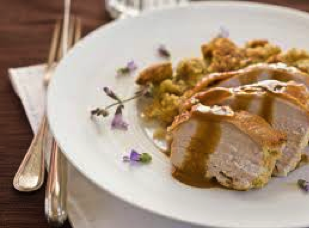
Roast Turkey with Bourbon Gravy
Epicurious
BON APPÉTIT DECEMBER 1998
Makes 12 servings
Ingredients
For turkey
1 16-pound turkey, excess fat from tail reserved, neck and giblets reserved for Turkey Stock
10 cups (about)Corn Bread Succotash Stuffing
Turkey Stock
3 cups water
For gravy
1/2 cup all purpose flour
1/4 cup bourbon
Preparation
Make turkey:
Position rack in bottom third of oven and preheat to 350°F. Pat turkey dry with paper towels and sprinkle inside and out with salt and pepper. Spoon Corn Bread Succotash Stuffing loosely into neck cavity and main cavity of turkey. Tie legs together. Using small metal skewers, pin neck skin to enclose stuffing. Sprinkle with salt and pepper.
Place turkey, breast side up, on rack in large pan. Add reserved turkey fat and 2 cups Turkey Stock to pan. Cover turkey loosely with foil. Roast 2 hours, basting every 30 minutes with pan drippings.
Remove foil. Add 3 cups water to pan. Roast turkey until thermometer inserted into thigh registers 180°F, basting occasionally with pan juices, about 2 1/2 hours longer. Transfer turkey to platter. Tent with foil. Let stand while making gravy.
Make gravy:
Strain juices from roasting pan into 8-cup glass measuring cup. Spoon fat off top of juices, returning 1/2 cup fat to roasting pan. Add enough remaining Turkey Stock to pan juices to measure 6 cups of broth mixture.
Heat fat in roasting pan atop 2 burners over medium heat. Whisk in flour. Stir until mixture is golden, about 2 minutes. Whisk in broth mixture, then bourbon. Simmer until gravy thickens, about 5 minutes. Season with salt and pepper. Serve gravy with turkey.
Corn Bread Succotash Stuffing
Epicurious
BON APPÉTIT DECEMBER 1998
YieldServes 12
Ingredients
Old-fashioned Corn Bread , crumbled
1/2 cup (1 stick) butter
2 medium onions, chopped
2 medium-size red bell peppers, seeded, chopped
2 celery stalks with leaves, chopped
1 10-ounce package frozen lima beans, thawed
2 cups frozen corn kernels, thawed
1/3 cup chopped fresh parsley
1 tablespoon crumbled dried sage leaves
1 tablespoon dried thyme
2 teaspoons crumbled dried rosemary
1 teaspoon salt
1/2 teaspoon ground black pepper
1/2 cup canned low-salt chicken broth
1 large egg, beaten to blend
Preparation
Place Old-fashioned Corn Bread on baking sheet. Let stand uncovered overnight to dry. Transfer to large bowl.
Melt butter in large skillet over medium heat. Add onions, red bell peppers and celery. Sauté until tender, about 15 minutes. Transfer sautéed vegetables to medium bowl. Mix in lima beans, corn kernels, herbs, salt and pepper. (Corn bread and vegetables can be made 1 day ahead. Cover separately. Store bread at room temperature; chill vegetables.)
Preheat oven to 350°F. Lightly butter 8-inch square baking dish. Stir vegetables, chicken broth and egg into corn bread. Reserve 10 cups stuffing for turkey; transfer remainder to prepared dish. Cover and bake stuffing alongside turkey until heated through, about 30 minutes.
Turkey Stock
Epicurious
BON APPÉTIT DECEMBER 1998
YieldMakes about 8 cups
Ingredients
3 pounds turkey wings, cut into 2-inch pieces
Turkey neck and giblets from 16-pound turkey
2 tablespoons vegetable oil
1 medium onion, chopped
1 carrot, chopped
1 celery stalk, chopped
16 cups (about) cold water
2 fresh parsley sprigs
1/2 teaspoon dried thyme
1/4 teaspoon whole black peppercorns
Preparation
Pat wings, neck and giblets dry with paper towels. Heat oil in heavy large pot over medium-high heat. Working in batches, add turkey parts to pot and sauté until brown on all sides, about 10 minutes. Using slotted spoon, transfer turkey parts to large bowl.
Add onion, carrot and celery to same pot. Sauté until onion is tender, about 2 minutes. Return turkey parts to pot. Add enough cold water to cover mixture by 2 inches. Bring liquid to boil. Skim off foam. Add parsley, thyme and peppercorns. Reduce heat to medium. Simmer until liquid is reduced by half, stirring occasionally, about 2 1/2 hours.
Strain stock into large bowl. Let stand 5 minutes. Spoon fat off top of stock. (Can be prepared 5 days ahead. Cool slightly. Cover and refrigerate.)
Chicken Tagine with Spring Vegetables
Epicurious
BON APPÉTIT APRIL 2003
Makes 8 servings
Ingredients
1 lemon, halved
6 medium artichokes, stems trimmed to 1/2 inch
1/2 cup (about) olive oil
1 pound onions, chopped
8 large garlic cloves, chopped
3 tablespoons (packed) grated lemon peel
1 tablespoon ground coriander
2 teaspoons Hungarian sweet paprika
1 1/2 teaspoons ground cumin
1 1/2 teaspoons ground ginger
1/4 teaspoon cayenne pepper
8 tablespoons chopped fresh parsley
8 tablespoons chopped fresh dill
8 tablespoons chopped fresh mint
4 pounds skinless boneless chicken thighs, trimmed of excess fat
4 cups low-salt chicken broth
3 fresh fennel bulbs, trimmed, bulbs quartered vertically
5 large carrots (about 1 1/2 pounds), peeled, cut into 1-inch lengths
Preparation
Fill large bowl with water; squeeze in juice from lemon. Working with 1 artichoke at a time, break off enough outer leaves to expose pale green leaves. Trim dark green areas off stem and base. Quarter artichoke lengthwise; trim artichoke quarters to 1 1/2-inch lengths. Scrape out choke; drop quarters into lemon water.
Heat 1/4 cup oil in heavy large skillet over medium-high heat. Add onions and sauté until translucent, about 5 minutes. Add next 7
Ingredients
and 6 tablespoons each parsley, dill, and mint; sauté 3 minutes longer. Scrape contents of skillet into heavy large pot; reserve skillet.
Sprinkle chicken with salt and pepper. Heat 2 tablespoons oil in same skillet over medium-high heat. Add 1/3 of chicken and sauté until golden, about 3 minutes per side. Transfer to pot with onion mixture. Repeat with remaining chicken in 2 more batches, adding more oil by tablespoonfuls if needed. Add broth to skillet; bring to boil, scraping up browned bits. Transfer broth to pot; add fennel and carrots. Drain artichokes and add to pot.
Bring tagine to boil. Cover, reduce heat to medium-low, and simmer until chicken is almost tender, about 20 minutes. Uncover and simmer until chicken and all vegetables are tender, about 15 minutes longer. Using slotted spoon, transfer chicken and vegetables to large bowl. Boil sauce until reduced enough to coat spoon, about 10 minutes. Season with salt and pepper. Return chicken and vegetables to sauce. (Can be made 1 day ahead. Cool slightly. Chill uncovered until cold, then cover and keep refrigerated.)
Rewarm tagine over medium heat. Transfer to large bowl. Sprinkle with 2 tablespoons each of parsley, dill, and mint.
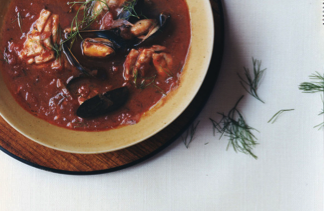
Quick and Easy Cioppino
Epicurious
BY PAUL GRIMES GOURMET OCTOBER 2007
Makes 4 servings
Active Time: 10 min Total Time: 40 min
Ingredients
1 fennel bulb, stalks discarded and bulb cut lengthwise into 6 wedges
1 medium onion, quartered
3 garlic cloves, smashed and peeled
3 tablespoons extra-virgin olive oil
2 Turkish bay leaves or 1 California
1 1/2 teaspoons dried thyme
1/8 teaspoon dried hot red-pepper flakes
1 (28-ounce) can crushed tomatoes in juice
1 1/2 cups water
1 cup full-bodied red wine such as Zinfandel or Syrah
1 (8-ounce) bottle clam juice
1 pound skinless fillets of thick white-fleshed fish such as halibut, hake, or pollack, cut into 2-inch chunks
1 pound cultivated mussels
Preparation
Pulse fennel, onion, and garlic in a food processor until coarsely chopped.
Heat oil in a 5- to 6-quart heavy pot over medium-high heat until it shimmers, then stir in chopped vegetables, bay leaves, thyme, red-pepper flakes, 1 1/2 teaspoons salt, and 1/2 teaspoon black pepper.
Cook, covered, over medium heat, stirring once or twice, until vegetables begin to soften, about 4 minutes.
Add tomatoes with their juice, water, wine, and clam juice and boil, covered, 20 minutes. Stir in seafood and cook, uncovered, until fish is just cooked through and mussels open wide, 4 to 6 minutes (discard any that remain unopened after 6 minutes). Discard bay leaves.
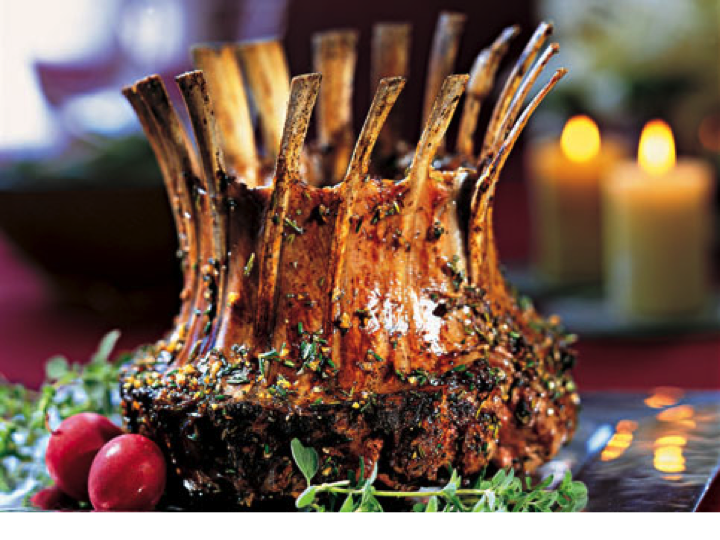
Crown Roast of Lamb with Rosemary and Oregano
Epicurious
BON APPÉTIT DECEMBER 2000
Makes 10 servings
Ingredients
1/4 cup chopped fresh rosemary
12 garlic cloves, minced
2 tablespoons chopped fresh oregano
1 tablespoon salt
2 teaspoons ground black pepper
2 crown roasts of lamb, each consisting of 14 chops (which are two 7-rib racks of lamb tied together)
Olive oil
Preparation
Preheat oven to 450°F. Mix chopped rosemary, minced garlic, chopped oregano, salt and black pepper in small bowl. Place crown roasts of lamb, spaced apart, on large baking sheet. Brush lamb all over with olive oil. Rub herb mixture all over lamb. Cover bones loosely with sheet of foil. Roast lamb until instant-read thermometer inserted into thickest part of lamb registers 125°F to 130°F for rare, about 20 minutes (or 130°F to 135°F for medium-rare, about 30 minutes; or 135°F to 140°F for medium, about 35 minutes).
Transfer lamb to platter; let stand 5 to 10 minutes. Remove foil and string. Cut lamb between ribs into chops and serve.

Braised Short Ribs with Red Wine and Pureed Vegetables
Epicurious
BY ANTONIO PISANIELLO BON APPÉTIT SEPTEMBER 2006 LA LOCANDO DI BU
Makes 6 servings
Ingredients
5 whole black peppercorns
1 small bay leaf
2 tablespoons coarse sea salt
2 tablespoons fresh rosemary leaves
2 tablespoons (packed) fresh sage leaves
4 1/2 pounds beef short ribs, well trimmed
1/2 cup corn oil
4 cups low-salt chicken broth, divided
4 tablespoons extra-virgin olive oil, plus additional for potatoes
2 cups chopped onion
1 1/2 cups finely chopped carrots
1 1/2 cups finely chopped celery
1/4 cup tomato paste
1 750-ml bottle Landa Vineyards Syrah
6 large white-skinned potatoes
Preparation
Grind first 5
Ingredients
in spice mill. Sprinkle beef with additional pepper and 3 1/2 teaspoons herb-salt mixture. Heat 1/2 cup corn oil in heavy large pot over high heat. Working in batches, add beef and brown well, turning occasionally, about 8 minutes per batch. Using tongs, transfer beef to large bowl. Pour off oil from pot. Add 1 cup broth to drippings in pot and bring to boil, scraping up any browned bits. Pour deglazed pan juices into small bowl.
Heat 4 tablespoons olive oil in same pot over medium-high heat. Add onion, carrots, and celery; sauté until beginning to brown, about 12 minutes. Add tomato paste and sauté 2 minutes. Add deglazed pan juices and bring to simmer. Return beef and any accumulated juices to pot. Add wine and remaining 3 cups broth and bring to boil. Reduce heat to low. Season with pepper. Cover and cook until beef is very tender, stirring occasionally, about 2 hours.
Using tongs, transfer beef to large bowl. Tilt pot and spoon off fat from surface of sauce. Working in batches, puree sauce with vegetables in blender until smooth; return to pot. Boil until reduced to 4 cups, about 15 minutes. Add beef and stir to heat through. DO AHEAD: Can be made 1 day ahead. Cool slightly. Refrigerate uncovered until cold, then cover and refrigerate. Bring to simmer before continuing.
Cook potatoes in pot of boiling salted water until tender, about 25 minutes. Drain. Place 1 potato on each plate; press to mash slightly. Drizzle with extra-virgin olive oil. Top with beef. Spoon sauce around beef and potatoes and serve.
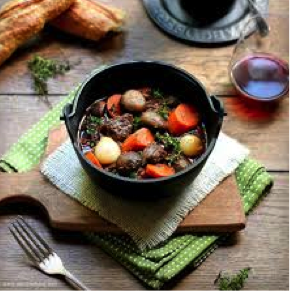
Red Wine Beef Stew
Epicurious
BY SARA QUESSENBERRY AND SUZANNE SCHLOSBERG MARCH 2011 THE GOOD NEIGHBOR COOKBOOK
Makes 8 servings
Active Time: 30 minutes Total Time: 3 hours
Ingredients
4 pounds chuck roast, cut into 2-inch pieces
1 1/2 teaspoons kosher salt
1 teaspoon freshly ground black pepper
3 tablespoons all-purpose flour
1 tablespoon olive oil
1/4 cup tomato paste
2 cups dry red wine, such as Pinot Noir or Syrah
4 cups low-sodium chicken broth
1 medium yellow onion, quartered
2 bay leaves
4 sprigs thyme
10 medium carrots (about 2 pounds), peeled and cut into 3-inch pieces
1 1/2 pounds baby white or red potatoes, halved
Preparation
Preheat the oven to 325°F.
Season the meat with salt and pepper, place in a large bowl, and toss with the flour.
Heat the oil in a large Dutch oven or wide-bottomed pot with a tight-fitting lid over medium-high heat. Cook the meat, in batches, until well browned on all sides, 6 to 8 minutes, transferring the pieces to a plate as they are browned. Pour off and discard any drippings from the pot.
Add the tomato paste, wine, broth, onion, bay leaves, thyme, and 2 of the carrots and bring to a boil. Return the meat and any juices back to the pot (the meat should be barely submerged in liquid), cover, and transfer to the oven. Cook for 2 hours.
Using tongs, remove and discard the cooked vegetables. Add the potatoes and the remaining 8 carrots to the pot, cover, and return to the oven. Cook until the meat and vegetables are fork-tender, about 1 hour more.
Cook’s Tip:
Stew always tastes better the day after it is made. Let the stew cool to room temperature before refrigerating. Before reheating, skim any visible fat from the surface and cook, covered, over medium-low heat on the stovetop, stirring occasionally, until heated through. Freeze in an airtight container for up to 2 months.
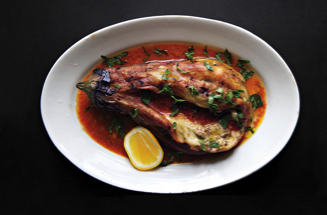
COAL-ROASTED EGGPLANTS
BY MELISSA HAMILTON AND CHRISTOPHER HIRSHEIMER BON APPÉTIT JULY 2013
Once you’ve charred them, you can drizzle these eggplants with your best extra-virgin olive oil and sprinkle with some coarse salt for a simple side. But they’re even better paired with one of the three luscious sauces (Yogurt and Sumac Sauce, Smoky Tomato Sauce, or Lemon-Mint Sauce) and some grilled flatbread or pita.
Makes 4 servings
Active time: 30 minutes Total time: 1 hour 30 minutes
Ingredients
2 small eggplants (about 1 pound total)
Smoky Tomato Sauce
Preparation
Prepare a hardwood-charcoal fire in a grill. Let coals cool to medium heat (coals should be covered with ash and glowing red with no black remaining).
Place 2 small eggplants (about 1 pound total) directly on coals and cook, turning occasionally, until skins are blackened and flesh has collapsed, 10-15 minutes. (Alternatively, grill on the grate of a gas or charcoal grill over medium-high heat, turning occasionally, 15-20 minutes.) Transfer to a rimmed baking sheet and let cool slightly.
Carefully remove skins from eggplants, leaving stems intact. Place eggplants on a wire rack set inside the same rimmed baking sheet and let stand 30 minutes to allow excess water to drain. Just before serving, split lengthwise and serve with Smoky Tomato sauce.
SMOKY TOMATO SAUCE
BY MELISSA HAMILTON AND CHRISTOPHER HIRSHEIMER BON APPÉTIT JULY 2013
Grill the tomatoes just before you place the eggplants in the coals.
Makes 4 servings
Active time: 15 minutes Total time: 25 minutes
Ingredients
2 small ripe tomatoes (about 1/2 pound)
3 anchovy fillets packed in oil, drained, finely chopped
1 small garlic clove, finely chopped
1 teaspoon harissa paste
1 teaspoon red wine vinegar
2 tablespoons extra-virgin olive oil plus more for serving
Kosher salt, freshly ground pepper
Coal-Roasted Eggplants
Chopped fresh flat-leaf parsley and lemon wedges (for serving)
Preparation
Grill tomatoes, turning occasionally, until skins are blackened and split, about 4 minutes. Press through a sieve set over a medium bowl; discard solids. Whisk in anchovies, garlic, harissa, vinegar, and 2 tablespoons oil; season with salt and pepper.
Spoon half of sauce onto a platter. Place eggplants on top, season with salt, and spoon remaining sauce over. Let sit 30 minutes to let flavors meld. Drizzle with oil, top with parsley, and serve with lemon wedges.
DO AHEAD: Smoky Tomato Sauce can be made 1 day ahead. Cover and chill.

EGGPLANT WITH LENTILS AND GOAT CHEESE
BY LARAINE PERRI SELF NOVEMBER 2013
CHRISTOPHER TESTANI
Eggplants are sensitive to cold; protect them in plastic wrap before refrigerating.
Makes 4 servings
Ingredients
2 globe eggplants (1 pound each), halved lengthwise
Vegetable oil cooking spray
3/4 teaspoon kosher salt, divided
1 tablespoon olive oil
1 medium onion, finely chopped
2 diced celery stalks
1 large carrot, peeled and diced
2 cloves garlic, finely chopped
2 cups packaged steamed lentils (such as Melissa’s)
1/2 cup low-sodium vegetable broth
2 tablespoons balsamic vinegar
1/4 teaspoon freshly ground black pepper
1/4 cup chopped fresh mint, plus torn leaves for serving
2 ounces crumbled goat cheese
Preparation
Heat oven to 475°. Remove pulp from eggplants; cut pulp from one eggplant into 1/4-inch cubes and discard the rest. Coat eggplant shells with cooking spray; sprinkle with 1/4 teaspoon salt. On a baking sheet lined with parchment paper, place eggplant shells open side down. In a bowl, coat eggplant cubes with cooking spray and toss with 1/4 teaspoon salt; place in one layer on a second baking sheet lined with parchment paper. Bake eggplant shells and cubes until tender, 10 minutes. Remove eggplant; reduce oven to 350°. In a medium nonstick skillet over medium heat, heat oil. Cook onion, celery and carrot until soft, 5 minutes. Add garlic; cook, 1 minute. Add lentils, eggplant cubes, broth, vinegar, pepper and remaining 1/4 teaspoon salt; reduce heat to simmer, stirring occasionally, 5 minutes. Stir in chopped mint. Flip shells on baking sheet and stuff with lentil-eggplant mixture; cover with aluminum foil and bake until warm; 10 minutes. Top with cheese and mint leaves.
Per serving: 282 calories, 8 g fat, 3 g saturated fat, 43 g carbohydrate, 17 g fiber, 15 g protein

Cauliflower Steaks with Olive & Herb Salsa
Cauliflower is a very healthy vegetable, containing many nutrients like thiamine, riboflavin and folic acid, as well as omega-3 fatty acids, vitamin K and vitamin C. It’s a good source of protein, fiber, potassium and manganese. It’s also great for cancer prevention, acts as an anti-inflammatory and provides protection from cardiovascular and cerebrovascular diseases.
We’re looking at a 1 1/2-inch slice of nutrition-packed cauliflower our our dinner plate, with a delicious salty and herby salsa.
The salsa can be made in a matter of minutes while the “steaks” are roasting.
The trickiest part? Slicing the cauliflower so it stays in one big piece! It’s easier once you get to the middle of the head of the cauliflower, where the stalk is. Make sure you use a sharp knife and handle the slices carefully so they don’t break apart.
Katrina Woodman \ Australian Good Taste magazine, May 2013
Makes 4 servings
Prep Time: 10 mins Cook Time: 35 mins Total Time: 45 mins
Ingredients
2 tablespoons olive oil
1 large (about 1.2kg) cauliflower, cut crossways into four 1.5cm-thick pieces
50g (1/4 cup) pimento-stuffed green olives, finely chopped
60ml (1/4 cup) extra virgin olive oil
1 tablespoon lemon juice
1 tablespoon baby capers
1 tablespoon chopped fresh continental parsley
2 teaspoons chopped fresh oregano
¼ teaspoon caster sugar
Preparation
Preheat oven to 180C. Line 2 baking trays with baking paper. Heat 2 teaspoons of the olive oil in a non-stick frying pan over medium-high heat. Add 1 cauliflower piece to the pan. Cook, turning, for 4-5 minutes or until golden. Transfer to prepared trays. Season with freshly ground salt and pepper. Repeat with the remaining olive oil and cauliflower pieces. Roast cauliflower for 12-15 minutes or until tender.
Meanwhile, combine the olives, extra virgin olive oil, lemon juice, capers, parsley, oregano and sugar in a small bowl. Season with freshly ground salt and pepper.
Transfer the cauliflower to a serving dish. Top with the olive mixture.
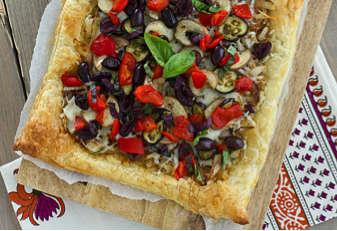
Caramelized Onion & Eggplant Puff Pastry Tart with Kalamata Olives, Roasted Red Peppers & Basil
Makes 4 servings
Prep Time: 1 hour Cook Time: 15 minutes Total Time: 1 hour, 15 minutes
Serving Size: 1/4 of tart
A puff pastry crust topped with caramelized onions, roasted eggplant, kalamata olives, and roasted red peppers. So much deliciousness!
Ingredients
olive oil mister or cooking spray
2 small (or baby) eggplants, halved lengthwise and cut into 1/4-inch slices
salt and pepper to taste
1 tbsp. olive oil
2 onions, thinly sliced
1 puff pastry sheet, rolled into a large rectangle (about 9 x 12, but no need to be precise)
1/2 c. shredded mozzarella or Italian-blend cheese
1/4 c. quartered kalamata olives
1/4 c. coarsely chopped roasted red peppers (I used the jarred kind)
1/4 c. basil, sliced into ribbons
Instructions
Preheat oven to 425 degrees.
Spray a rimmed baking sheet with olive oil or cooking spray. Place eggplant slices onto sheet and spray tops with additional olive oil. Season with salt and pepper and roast for 20-30 minutes or until softened and just beginning to brown, turning slices over halfway through cooking time. Remove from oven and set aside. Lower oven temperature to 400 degrees.
While eggplant is baking, start caramelizing the onions. Heat olive oil in a large skillet over low heat. Add onions and a pinch of salt. Allow onions to slowly caramelize, stirring occasionally at first and more frequently once onions begin to brown. Depending on your stove, this could take anywhere between 30 minutes to an hour. Be patient–it’s worth it! Remove from heat.
Place rolled-out puff pastry dough onto a baking sheet that’s been lined with parchment paper. Bake for 10 minutes or until golden brown. Remove from oven and use a spoon or spatula to push down the center of the crust, leaving about a 1-inch margin on all sides.
Spread caramelized onions onto crust. Top with cheese, then roasted eggplant slices, olives, and red peppers. Return to oven and bake 5 minutes, or until cheese has melted. Scatter basil ribbons onto tart just before serving.
Grilled Salmon with Quick Blueberry Pan Sauce
BY LORI LONGBOTHAM BON APPÉTIT AUGUST 2010
Makes 4 servings
Active Time: 40 minutes Total Time: 40 minutes
Ingredients
1 tablespoon olive oil plus additional for brushing
3/4 cup sliced shallots
1 garlic clove, thinly sliced
1/4 teaspoon coarse kosher salt plus additional for seasoning
1/4 teaspoon chopped fresh thyme plus additional for seasoning
1/8 teaspoon ground allspice plus additional for seasoning
1 cup fresh blueberries
1/4 cup water
1 tablespoon balsamic vinegar
4 7-ounce salmon steaks or fillets with skin (each about 3/4 inch thick)
3 tablespoons thinly sliced fresh mint, divided
Preparation
Heat 1 tablespoon oil in large skillet over medium heat. Add shallots; sauté until softened, about 5 minutes. Add garlic, 1/4 teaspoon coarse salt, 1/4 teaspoon thyme, and 1/8 teaspoon allspice. Stir until fragrant, about 30 seconds. Add blueberries, 1/4 cup water, and vinegar. Stir to blend. Mash berries with potato masher or back of fork and cook until sauce thickens, stirring often, 3 to 4 minutes. Season with freshly ground black pepper. Remove from heat. DO AHEAD Can be made 2 hours ahead. Let stand at room temperature. Rewarm before using.
Brush grill rack with oil. Prepare barbecue (medium-high heat). Brush salmon on both sides with oil; sprinkle with coarse salt, thyme, allspice, and black pepper.
Grill salmon until just opaque in center, 4 to 5 minutes per side. Transfer to plates. Stir 2 tablespoons sliced mint into warm blueberry sauce. Spoon sauce over salmon and sprinkle with remaining 1 tablespoon mint. Serve immediately.

Grilled Pork Tenderloin with Fresh Fig Skewers
BY KAREN ADLER & JUDITH FERTIG APRIL 2012 THE GARDENER & THE GRILL
Makes 4 servings
Ingredients
One (1 to 1 1/4 pounds) pork tenderloin or center-cut pork filet
2 tablespoons olive oil
Fine kosher or sea salt and freshly ground black pepper to taste
4 long rosemary branches or wooden skewers, soaked in water for at least 15 minutes
12 small ripe figs
4 ounces goat cheese
2 teaspoons honey
1 1/2 teaspoons finely chopped fresh rosemary
Preparation
Prepare a hot fire in your grill. Brush the tenderloin with the olive oil and season with salt and pepper.
Remove the skewers from the water. Pierce the figs through the middle with a metal skewer or ice pick to make a hole. Then thread 3 figs onto each rosemary or wooden skewer. Lightly brush the figs with olive oil.
Place the pork tenderloin directly over the fire. Grill for 2 to 3 minutes per side (the center-cut pork loin filet for 5 to 7 minutes per side), turning a quarter turn at a time, until an instant-read meat thermometer inserted in the thickest part registers 140°F for medium and the meat is juicy and slightly pink in the center.
At the same time, place the skewered figs over the fire, turning several times and cooking for about 5 to 6 minutes until they are heated through. When they’re caramelized and soft, remove the skewers from the heat and keep warm.
Let the pork rest for about 5 minutes, and then cut on the diagonal into 1- to 2-inch-thick slices.
To serve, arrange 3 slices of pork with a skewer of figs on each plate, all topped with crumbled goat cheese, drizzled with 1/2 teaspoon honey, and a sprinkled with chopped rosemary.
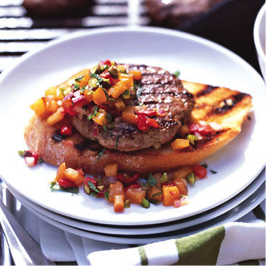
Open-Face Lamb Burgers with Pistachio-Apricot Relish
CHERYL ALTERS JAMISON AND BILL JAMISON BON APPÉTIT JULY 2007
Makes 6 servings
Ingredients
2 1/2 pounds freshly ground lamb (preferably shoulder)
2 1/2 teaspoons coarse kosher salt plus more for relish
1 cup diced pitted fresh apricots
1/4 cup finely chopped red onion
1/4 cup diced drained roasted red pepper from jar
2 tablespoons Sherry wine vinegar
2 tablespoons extra-virgin olive oil
1/4 teaspoon curry powder
1/4 teaspoon sugar
1 cup coarsely chopped unsalted natural pistachios
3 tablespoons chopped fresh mint
Nonstick vegetable oil spray
6 (4-inch-diameter) slices (about 1/2 inch thick) sourdough bread
Preparation
Place ground lamb in large bowl; sprinkle 2 1/2 teaspoons coarse salt evenly over. Gently mix in salt and shape meat into 6 patties, each about 3/4 inch thick. DO AHEAD Patties can be prepared 6 hours ahead. Arrange on baking sheet, cover, and refrigerate.
Mix apricots and next 6
Ingredients
in medium bowl; season with salt. Mix chopped pistachios and mint into relish.
Spray grill rack with nonstick spray. Prepare barbecue (medium heat). Place burgers on grill. Place bread slices at edges to toast. Cook burgers to desired doneness and until slightly charred, about 5 minutes per side for mediumrare. Transfer bread to plates. Top each with burger. Spoon relish atop burgers.
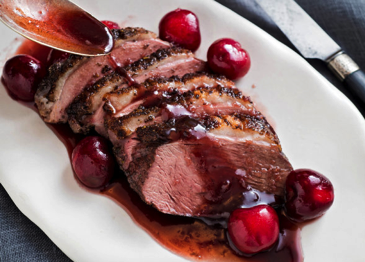
Duck With Cherries and Red Wine Vinegar
David Tanis – New York times
Makes 6 servings
Total Time: 1 hour
Ingredients
FOR THE DUCK
2 Muscovy duck breasts, about 1 pound each
Kosher salt
1 teaspoon black peppercorns
½ teaspoon allspice berries
4 cloves
2 bay leaves
½ teaspoon fennel seeds
FOR THE SAUCE
¼ cup turbinado or raw sugar
½ cup red wine vinegar
½ cup Landa Vineyards Syrah
1 cup chicken broth
1 tablespoon grated fresh ginger
Pinch of cayenne
Kosher salt
2 tablespoons butter
½ pound ripe cherries, left whole or halved and pitted
2 teaspoons granulated sugar
1 tablespoon kirsch or Cognac
Preparation
Step 1: Trim excess fat from duck breasts, leaving a 1/4-inch layer covering the breast. (Save fat trimmings to render and use for another purpose.) With a sharp knife, lightly score fat cover diagonally in two directions, taking care not to cut too deeply and expose meat. Turn breasts over and remove the thin tenderloins from underside. Trim away any veiny or ragged bits. (Save meaty trimmings for making stock.) Season generously on both sides with salt.
Step 2: Pulverize the peppercorns, allspice berries, cloves, bay leaves and fennel seed in a mortar or electric spice mill. Sprinkle spice mixture over duck breasts; massage seasoning into meat on both sides. For more-intense flavor, do this several hours ahead or overnight and refrigerate (recommended). Bring duck to room temperature before cooking.
Step 3: Make the sauce: Put turbinado sugar and red wine vinegar in a saucepan and simmer over medium-high heat for 2 minutes, until syrupy. Add red wine and chicken broth and simmer briskly until sauce coats spoon, about 5 minutes. Stir in ginger, cayenne and 1/2 teaspoon salt. Set aside. You should have about 1 cup sauce. (Sauce may be made a day or two in advance, if desired.)
Step 4: Place a wide cast-iron pan over medium high heat. When pan is hot, place duck breasts side by side, skin side down. Let sizzle gently for about 7 minutes, until skin is crisp and golden, turning down heat as necessary to keep from getting too dark. Turn breasts over and cook 5 to 7 minutes more. (Alternatively, finish cooking breasts in a 400-degree oven.) Check temperature frequently with an instant-read thermometer; internal temperature should be a bit less than 125 degrees. Remove breasts and let rest on a warm platter for 8 to 10 minutes.
Step 5: To finish sauce, put butter in a saucepan over medium high heat. Add cherries and granulated sugar and cook for a minute or two, stirring, until cherries are heated through and beginning to get juicy. Add kirsch and cook 1 minute more, then add previously prepared sauce and bring to a simmer.
Step 6: Thinly slice duck breasts at an angle and arrange slices on a platter. Spoon some of the sauce and cherries over meat and pass remaining sauce at table.
Wine and Cheese Pairing Guidelines
There are only two strict rules for pairing Wine and Cheese. The first rule is to match acidity. Tart wines should pair with sharper cheeses and mellow wines should pair with creamier cheeses. The second rule is to match power. Do not let a strong wine overpower a mild cheese, or vice versa. One additional tip, albeit not a rule, is to create a wine and cheese pairing by selecting products from the same region of the world. This brings in the element of terroir, which describes how foods get their qualities from the earth and the climate, and that a wine and a cheese from the same region should share complementary properties.
We at Landa Vineyards like to stick to the first two rules, but love to explore matching our wines with cheeses from all over the world. A cheese has to be powerful and full of flavor to stand up to our Estate Syrah. We believe notably strong cheeses from the Old World, blues from Sonoma and vintage Cheddars from England and Ireland are the best cheeses for our flagship reds. Here a few of our top picks for pairing with our Landa Vineyards Syrah. These cheeses can be found online at igourmet.com.
Abbaye de Belloc – French Sheep’s Milk from the Pyrenees
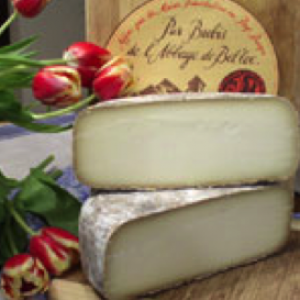
We’re happy to bring you this cheese from the Pays Basque region of Aquitaine (French Pyrenees). Its milk comes from red-nosed Manech ewes raised on farms adjacent to the Abbaye de Notre Dame de Belloc. The Abbey has profited from milder climates and the rise of pastoral civilizations. Monks of this Benedictine Monastery continue to teach the art of cheese-making to local shepherds. Its rind is naturally gray with patches of red, orange, and yellow. This cheese has a fine, closed texture and is is rich with butter-fat. The lingering flavor, like caramelized brown sugar, is the result of six months of maturation.
Smoked Idiazabal – Sheep’s Milk from the Spanish Pyrenees

This handmade, unpasteurized sheep’s milk cheese comes from the Spanish Pyrenees. Idiazabal is naturally smoked with a hard, but edible, orange-brown rind. In the old days, Basque shepherds lived in small mountain huts and had no space to store and age their cheeses other than inside their stone chimneys. As it turned out, people enjoyed the smoky flavor that the cheese acquired from aging inside the chimneys, and Idiazabal spread throughout Spain. Today, Idiazabal is produced in more modern facilities, but the process is still all-natural. The cheese is as delicious as ever, and the quality is more consistent. We love its perfume-y bouquet, tanginess, and rich, buttery flavor and enthusiastically recommend Idiazabal as one of Spain’s greatest cheeses.
Comte Reserve – Aged Cow’s Milk from French Alps
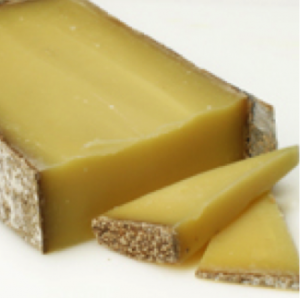
Made from a centuries-old recipe, 70-pound wheels of Comte Reserve have been produced since the reign of Charlemagne, when there were no separate entities named France and Switzerland. Comte Reserve has the highest production figures of all the French AOC cheeses, as cheese makers work to satisfy the world’s hunger for this exceptional cheese. Created by local villagers in alpine dairies called “Fruiteries”, its milk comes only from Montbeliarde and Tachete de L’est cows. Contributing to its unique flavor, morning and evening milkings are mingled before the cheesemaking process. For transforming the milk into curds, the cheesemaker must only use natural ferments to receive the Comte seal. During aging, the curd is cooked, then pressed, with a natural brushed rind that comes from weekly care.
These Reserve wheels are aged for one year, resulting in sweet and nutty masterpieces with less bite than its twin from Switzerland. It has a satiny, ivory-colored body and a scattering of holes the size of a hazelnut. Each round reveals differences in the composition of its flavor, depending on the micro-region where it was produced, the season, the particular technique of the cheese maker, and the cellar where it was matured. It pairs well with Landa Vineyards
Agour Ossau-Iraty
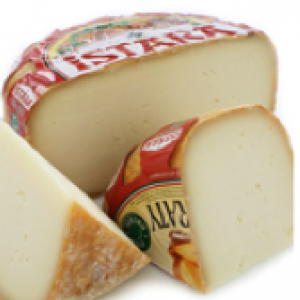
Amidst the scenic rolling mountains of the Pyrenees, the geographic border dividing France and Spain, lie vast pastures providing fertile grazing for milk-giving sheep. It is from this unpasteurized milk that Agour, a family company steeped in tradition, creates this magnificent cheese. Aged for a minimum of twelve months, this AOC protected cheese is of a quality and complexity rarely seen. A slightly dry texture gives way to a creamy, buttery quality, and the flavors hint at a subtle mingling of herbs and fruit, with slightly nutty undertones. A real gem, and one you’re sure to enjoy.
The cheese gets its name from its location in the Ossau Valley bordering the Iraty Forest on the southern border of France
For dessert, try Agour Ossau-Iraty accompanied with a tart, dark cherry cheese spread – an incredible combination with our 2012 Syrah.
Tomme de Savoie
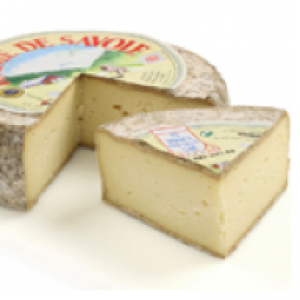
The word tomme implies that a cheese is made from the milk of more than one herd. Tomme de Savoie is made by an expert cheesemaker and is always of exceptional quality. It has a beautifully rustic, gray-brown, fuzzy, inedible, thick rind. The cheese inside is robust with slight overtones of salt and an unmistakably raw flavor. This French, unpasteurized cow’s milk cheese has a charming simplicity. It is absolutely wonderful paired with sausages, fruit, bread, and wine. All the good things in life!
Rogue River Blue
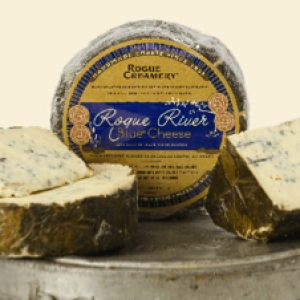
This hand crafted raw cow’s milk blue veined cheese develops a beautiful natural rind as a result of hand turning and tending the cheese several times a week. The wheels are aged for up to a year in Rogue Creamery’s special rooms which were constructed to simulate the ancient caves in Roquefort, France.
This aging process imparts into the cheese naturally occurring molds that Rogue consider to be their signature Rogue River Valley Terroir. The flavors of the terroir include hints of sweet woodsy pine, wild ripened berries, hazelnuts, morels and pears.
To preserve this cheese they hand wrap each wheel in Syrah grape leaves harvested from Carpenter Hill Vineyards in the Rogue River Valley. These leaves have been macerated in Clear Creek’s Pear Brandy and tied with raffia. The grape leaves add additional complexity to the terroir driven flavors of the cheese and preserve its moist creamy texture.
Point Reyes Original Blue
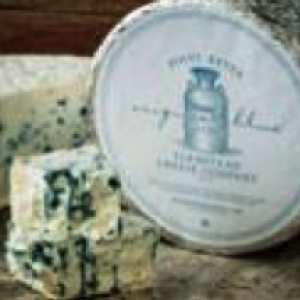
This award-winning blue comes from Tomales Bay, California, very close to where some of the best California Syrah, including Landa Vineyards, are produced. This creamy yet crumbly blue has a fantastically rich and full-bodied flavor produced through a combination of premium milk and a unique blue culture.
Bleating Heart Cheese Company – Fat Bottom Girl

Each wheel of “Fat Bottom Girl” Sonoma County-made cheese is totally hand crafted with the raw milk from dairy sheep who live and graze freely on open pastures. Fat Bottom Girl is approachable and appealing to both cheese geeks & novices alike. The orangish straw-colored rind is achieved by careful hand-rubbing with a salt water solution during the 3 to 4 month aging period, which at certain times of the year, also gives it little extra funky aroma. The cheese has a firm ivory paste with a toothsome bite and a touch of salt, conveying the subtle nutty & buttery goodness of sheep milk. Fat Bottom Girl is amazingly addictive when paired with pepper jams. This cheese is robust enough to stand up to Landa Vineyards Estate Syrah and complements the peppery notes in the wine remarkably well. This cheese has won numerous awards including the Super Gold Winner at the 2013 World Cheese Awards in England and Best of Show in the California State Fair Competition.
Barbers 1833 Vintage Reserve Cheddar – English Cheddar
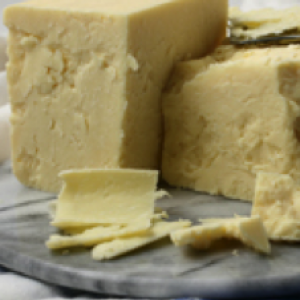
The Barber family has been farming and making cheese at Maryland Farm in Ditcheat, Somerset England since 1833. Today the Barber farms comprise 2500 acres of prime Somerset dairy land and are home to some 2,000 dairy cows. They continue to use traditional cheddaring’ techniques, combined with a unique collection of traditional starter cultures, to create a truly authentic West Country Farmhouse cheddar.
The secret behind Barber’s 1833’s unique character lies in the use of a collection of traditional starter cultures for which the family are the sole guardians. These cultures are the friendly bacteria added to the milk to start the cheese-making process and are the most important ingredient in determining the flavor and quality of the finished cheese. Barber’s cultures are derived from bacteria naturally occurring in the milk of the region and have been isolated for their ability to produce great flavors and traditional cheddar character.
Barber’s are determined to preserve this collection of natural mixed starter cultures and to this end, have created a unique laboratory, dedicated to their preservation at Maryland Farm. It is these cultures that give 1833 its unique complexity of flavor, and they are determined to protect them – and the heritage of West Country Cheddar – for generations to come. Barber’s 1833 Vintage Reserve Cheddar is the culmination of all their achievements. A deliciously creamy cheese with both savory and naturally sweet notes. Only the very best leaves the farm with the 1833 stamp.
Kerrygold Aged Cheddar – Irish Cheddar
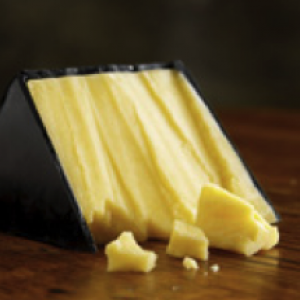
Kerrygold, the Irish cheese crafters that produce Blarney and Dubliner, make a spectacular, limited production two-year aged Vintage Cheddar. Encased in black wax to differentiate it from less-aged Cheddars, this special cheddar is the result of a careful grading process such that only the best are allowed to bear the “Vintage” label. This connoisseur’s cheddar, notable for its rich, rounded flavor and firm, smooth body, deserves a place on the cheese board alongside your choice of the world’s other great cheeses.
Wine and Cheese Pairing Guidelines
There are only two strict rules for pairing Wine and Cheese. The first rule is to match acidity. Tart wines should pair with sharper cheeses and mellow wines should pair with creamier cheeses. The second rule is to match power. Do not let a strong wine overpower a mild cheese, or vice versa. One additional tip, albeit not a rule, is to create a wine and cheese pairing by selecting products from the same region of the world. This brings in the element of terroir, which describes how foods get their qualities from the earth and the climate, and that a wine and a cheese from the same region should share complementary properties.
www.igourmet.com
Cheeses That Pair With Landa Vineyards Estate Syrah
The Syrah grape is famous for being the primary component in French red wines from the Rhone region. Syrah typically has low acidity and strong berry flavors. We prefer to pair Syrah wine with French sheep’s milk cheeses like Abbaye de Belloc or aged cow’s milk cheeses from the French Alps like Comté Reserve. For something different, pair a glass of Syrah with a lightly smoked cheese like Spanish Idizabal.
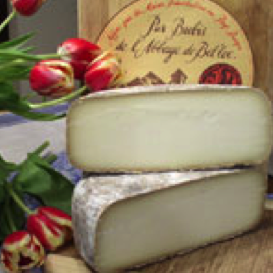
Abbaye de Belloc – French sheep’s milk from the Pyrenees
We’re happy to bring you this cheese from the Pays Basque region of Aquitaine (French Pyrenees). Its milk comes from red-nosed Manech ewes raised on farms adjacent to the Abbaye de Notre Dame de Belloc. The Abbey has profited from milder climates and the rise of pastoral civilizations. Monks of this Benedictine Monastery continue to teach the art of cheese-making to local shepherds. Its rind is naturally gray with patches of red, orange, and yellow. This cheese has a fine, closed texture and is is rich with butter-fat. The lingering flavor, like caramelized brown sugar, is the result of six months of maturation.

Comte Reserve – Aged cow’s milk from French Alps
Made from a centuries-old recipe, 70-pound wheels of Comte Reserve have been produced since the reign of Charlemagne, when there were no separate entities named France and Switzerland. Comte Reserve has the highest production figures of all the French AOC cheeses, as cheese makers work to satisfy the world’s hunger for this exceptional cheese. Created by local villagers in alpine dairies called “Fruiteries”, its milk comes only from Montbeliarde and Tachete de L’est cows. Contributing to its unique flavor, morning and evening milkings are mingled before the cheesemaking process. For transforming the milk into curds, the cheesemaker must only use natural ferments to receive the Comte seal. During aging, the curd is cooked, then pressed, with a natural brushed rind that comes from weekly care.
These Reserve wheels are aged for one year, resulting in sweet and nutty masterpieces with less bite than its twin from Switzerland. It has a satiny, ivory-colored body and a scattering of holes the size of a hazelnut. Each round reveals differences in the composition of its flavor, depending on the micro-region where it was produced, the season, the particular technique of the cheese maker, and the cellar where it was matured. It pairs well with Landa Vineyards
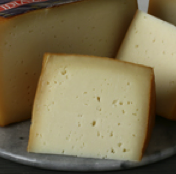
Smoked Idiazabal – Sheep’s milk from the Spanish Pyrenees
This handmade, unpasteurized sheep’s milk cheese comes from the Spanish Pyrenees. Idiazabal is naturally smoked with a hard, but edible, orange-brown rind. In the old days, Basque shepherds lived in small mountain huts and had no space to store and age their cheeses other than inside their stone chimneys. As it turned out, people enjoyed the smoky flavor that the cheese acquired from aging inside the chimneys, and Idiazabal spread throughout Spain. Today, Idiazabal is produced in more modern facilities, but the process is still all-natural. The cheese is as delicious as ever, and the quality is more consistent. We love its perfume-y bouquet, tanginess, and rich, buttery flavor and enthusiastically recommend Idiazabal as one of Spain’s greatest cheeses.
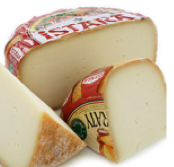
Agour Ossau-Iraty
Amidst the scenic rolling mountains of the Pyrenees, the geographic border dividing France and Spain, lie vast pastures providing fertile grazing for milk-giving sheep. It is from this unpasteurized milk that Agour, a family company steeped in tradition, creates this magnificent cheese. Aged for a minimum of twelve months, this AOC protected cheese is of a quality and complexity rarely seen. A slightly dry texture gives way to a creamy, buttery quality, and the flavors hint at a subtle mingling of herbs and fruit, with slightly nutty undertones. A real gem, and one you’re sure to enjoy.
The cheese gets its name from its location in the Ossau Valley bordering the Iraty Forest on the southern border of France
For dessert, try Agour Ossau-Iraty accompanied with a tart, dark cherry cheese spread – an incredible combination with our 2012 Syrah
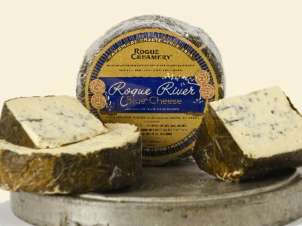
Point Reyes Blue
This award-winning blue comes from Tomales Bay, California, very close to Santa Rosa where some of the best California Syrahs are produced. This creamy yet crumbly blue has a fantastically rich and full-bodied flavor produced through a combination of premium milk and a unique blue culture.
Wexford Cheddar
County Wexford produces some of the creamiest milk found on the Emerald Isle. This milk is skillfully turned into sharp Irish cheddar as it ages for at least a year. Due to the richness of the milk, this cheese still keeps a buttery flavor once it comes out of the Wexford aging rooms.
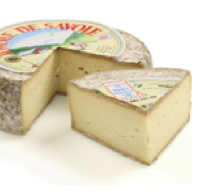
Tomme de Savoie
The word tomme implies that a cheese is made from the milk of more than one herd. Tomme de Savoie is made by an expert cheesemaker and is always of exceptional quality. It has a beautifully rustic, gray-brown, fuzzy, inedible, thick rind. The cheese inside is robust with slight overtones of salt and an unmistakably raw flavor. This French, unpasteurized cow’s milk cheese has a charming simplicity. It is absolutely wonderful paired with sausages, fruit, bread, and wine. All the good things in life!

Rogue River Blue by Rogue Creamery
This hand crafted raw cow’s milk blue veined cheese develops a beautiful natural rind as a result of hand turning and tending the cheese several times a week. The wheels are aged for up to a year in Rogue Creamery’s special rooms which were constructed to simulate the ancient caves in Roquefort, France.
This aging process imparts into the cheese naturally occurring molds that Rogue consider to be their signature Rogue River Valley Terroir. The flavors of the terroir include hints of sweet woodsy pine, wild ripened berries, hazelnuts, morels and pears.
To preserve this cheese they hand wrap each wheel in Syrah grape leaves harvested from Carpenter Hill Vineyards in the Rogue River Valley. These leaves have been macerated in Clear Creek’s Pear Brandy and tied with raffia. The grape leaves add additional complexity to the terroir driven flavors of the cheese and preserve its moist creamy texture.

Barbers 1833 Vintage Reserve Cheddar
The Barber family has been farming and making cheese at Maryland Farm in Ditcheat, Somerset England since 1833. Today the Barber farms comprise 2500 acres of prime Somerset dairy land and are home to some 2,000 dairy cows. They continue to use traditional cheddaring’ techniques, combined with a unique collection of traditional starter cultures, to create a truly authentic West Country Farmhouse cheddar.
The secret behind Barber’s 1833’s unique character lies in the use of a collection of traditional starter cultures for which the family are the sole guardians. These cultures are the friendly bacteria added to the milk to start the cheese-making process and are the most important ingredient in determining the flavor and quality of the finished cheese. Barber’s cultures are derived from bacteria naturally occurring in the milk of the region and have been isolated for their ability to produce great flavors and traditional cheddar character.
Barber’s are determined to preserve this collection of natural mixed starter cultures and to this end, have created a unique laboratory, dedicated to their preservation at Maryland Farm. It is these cultures that give 1833 its unique complexity of flavor, and they are determined to protect them – and the heritage of West Country Cheddar – for generations to come. Barber’s 1833 Vintage Reserve Cheddar is the culmination of all their achievements. A deliciously creamy cheese with both savory and naturally sweet notes. Only the very best leaves the farm with the 1833 stamp.
Kerrygold Dubliner
Dubliner was first described to us as a mixture between Cheddar and Parmigiano Reggiano. This description is quite accurate. Dubliner tastes of a mature Cheddar with the sweet aftertaste of Reggiano. Created by the Irish company Kerrygold and named after Ireland’s capital city, this cheese shares traits with several well-known cheeses, but the combination creates a flavor that is completely unique.

Kerrygold Aged Cheddar
Kerrygold, the Irish cheese crafters that produce Blarney and Dubliner, make a spectacular, limited production two-year aged Vintage Cheddar. Encased in black wax to differentiate it from less-aged Cheddars, this special cheddar is the result of a careful grading process such that only the best are allowed to bear the “Vintage” label. This connoisseur’s cheddar, notable for its rich, rounded flavor and firm, smooth body, deserves a place on the cheese board alongside your choice of the world’s other great cheeses.


